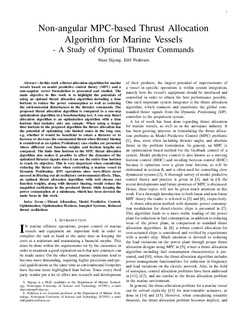| dc.contributor.author | Skjong, Stian | |
| dc.contributor.author | Pedersen, Eilif | |
| dc.date.accessioned | 2017-11-15T11:40:27Z | |
| dc.date.available | 2017-11-15T11:40:27Z | |
| dc.date.created | 2017-03-28T10:10:04Z | |
| dc.date.issued | 2017 | |
| dc.identifier.citation | IEEE Transactions on Transportation Electrification. 2017, PP (99), . | nb_NO |
| dc.identifier.issn | 2332-7782 | |
| dc.identifier.uri | http://hdl.handle.net/11250/2466399 | |
| dc.description.abstract | In this paper, a thrust allocation algorithm for marine vessels based on model predictive control (MPC) theory and a nonangular vector formulation is presented and studied. The main objective in this paper is to highlight the potentials of using an optimal thrust allocation algorithm including a time horizon to reduce the power consumption as well as reducing the environmental disturbances in the thruster commands. The proposed thrust allocation algorithm is compared with a one-step optimization algorithm in a benchmarking test. A one-step thrust allocation algorithm is an optimization algorithm with a time horizon that includes only one sample. When using a longer time horizon in the proposed algorithm, the thrust allocation has the potential of optimizing rate limited states in the long run, e.g., whether it would be beneficial to rotate a thruster or to increase or decrease the commanded thrust when thruster biasing is considered as an option. Preliminary case studies are presented where different cost function weights and horizon lengths are compared. The finite time horizon in the MPC thrust allocation algorithm also makes it possible to affect the dynamics of the optimized thruster signals since it can use the entire time horizon to reach its objective. This is very important when considering reducing the thrust rates when controlling a marine vessel in dynamic positioning operations since wave filters never succeed in filtering out all oscillatory environmental effects. Thus, an optimal thrust allocation algorithm with well-chosen cost function weights, along with thruster biasing, would reduce the magnified oscillations in the produced thrust, while keeping the power consumption at a minimum, which has been devoted the main focus of this paper. | nb_NO |
| dc.language.iso | eng | nb_NO |
| dc.publisher | Institute of Electrical and Electronics Engineers (IEEE) | nb_NO |
| dc.title | Non-angular MPC-based Thrust Allocation Algorithm for Marine Vessels - A Study of Optimal Thruster Commands | nb_NO |
| dc.type | Journal article | nb_NO |
| dc.description.version | acceptedVersion | nb_NO |
| dc.source.pagenumber | 17 | nb_NO |
| dc.source.volume | PP | nb_NO |
| dc.source.journal | IEEE Transactions on Transportation Electrification | nb_NO |
| dc.source.issue | 99 | nb_NO |
| dc.identifier.doi | 10.1109/TTE.2017.2688183 | |
| dc.identifier.cristin | 1461599 | |
| dc.relation.project | Norges forskningsråd: 225322 | nb_NO |
| dc.description.localcode | © 2017 IEEE. Personal use of this material is permitted. Permission from IEEE must be obtained for all other uses, in any current or future media, including reprinting/republishing this material for advertising or promotional purposes, creating new collective works, for resale or redistribution to servers or lists, or reuse of any copyrighted component of this work in other works. | nb_NO |
| cristin.unitcode | 194,64,20,0 | |
| cristin.unitname | Institutt for marin teknikk | |
| cristin.ispublished | false | |
| cristin.fulltext | preprint | |
